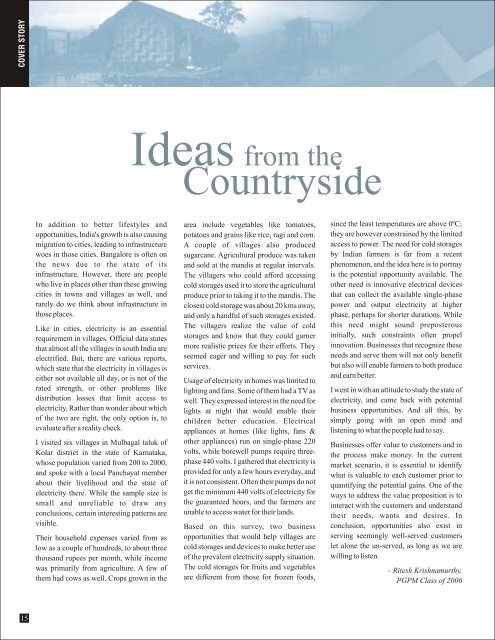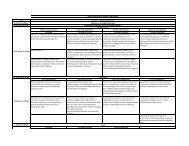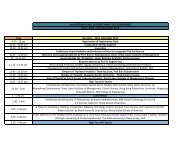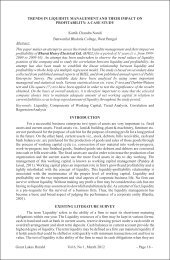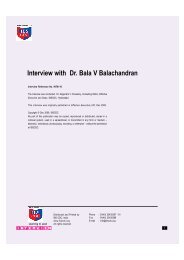Gravity Magazine_Final - Great Lakes
Gravity Magazine_Final - Great Lakes
Gravity Magazine_Final - Great Lakes
Create successful ePaper yourself
Turn your PDF publications into a flip-book with our unique Google optimized e-Paper software.
COVER STORY<br />
15<br />
In addition to better lifestyles and<br />
opportunities, India's growth is also causing<br />
migration to cities, leading to infrastructure<br />
woes in those cities. Bangalore is often on<br />
the news due to the state of its<br />
infrastructure. However, there are people<br />
who live in places other than these growing<br />
cities in towns and villages as well, and<br />
rarely do we think about infrastructure in<br />
those places.<br />
Like in cities, electricity is an essential<br />
requirement in villages. Official data states<br />
that almost all the villages in south India are<br />
electrified. But, there are various reports,<br />
which state that the electricity in villages is<br />
either not available all day, or is not of the<br />
rated strength, or other problems like<br />
distribution losses that limit access to<br />
electricity. Rather than wonder about which<br />
of the two are right, the only option is, to<br />
evaluate after a reality check.<br />
I visited six villages in Mulbagal taluk of<br />
Kolar district in the state of Karnataka,<br />
whose population varied from 200 to 2000,<br />
and spoke with a local Panchayat member<br />
about their livelihood and the state of<br />
electricity there. While the sample size is<br />
small and unreliable to draw any<br />
conclusions, certain interesting patterns are<br />
visible.<br />
Their household expenses varied from as<br />
low as a couple of hundreds, to about three<br />
thousand rupees per month, while income<br />
was primarily from agriculture. A few of<br />
them had cows as well. Crops grown in the<br />
Ideas<br />
from the<br />
Countryside<br />
area include vegetables like tomatoes,<br />
potatoes and grains like rice, ragi and corn.<br />
A couple of villages also produced<br />
sugarcane. Agricultural produce was taken<br />
and sold at the mandis at regular intervals.<br />
The villagers who could afford accessing<br />
cold storages used it to store the agricultural<br />
produce prior to taking it to the mandis. The<br />
closest cold storage was about 20 kms away,<br />
and only a handful of such storages existed.<br />
The villagers realize the value of cold<br />
storages and know that they could garner<br />
more realistic prices for their efforts. They<br />
seemed eager and willing to pay for such<br />
services.<br />
Usage of electricity in homes was limited to<br />
lighting and fans. Some of them had a TV as<br />
well. They expressed interest in the need for<br />
lights at night that would enable their<br />
children better education. Electrical<br />
appliances at homes (like lights, fans &<br />
other appliances) run on single-phase 220<br />
volts, while borewell pumps require threephase<br />
440 volts. I gathered that electricity is<br />
provided for only a few hours everyday, and<br />
it is not consistent. Often their pumps do not<br />
get the minimum 440 volts of electricity for<br />
the guaranteed hours, and the farmers are<br />
unable to access water for their lands.<br />
Based on this survey, two business<br />
opportunities that would help villages are<br />
cold storages and devices to make better use<br />
of the prevalent electricity supply situation.<br />
The cold storages for fruits and vegetables<br />
are different from those for frozen foods,<br />
since the least temperatures are above 0ºC;<br />
they are however constrained by the limited<br />
access to power. The need for cold storages<br />
by Indian farmers is far from a recent<br />
phenomenon, and the idea here is to portray<br />
is the potential opportunity available. The<br />
other need is innovative electrical devices<br />
that can collect the available single-phase<br />
power and output electricity at higher<br />
phase, perhaps for shorter durations. While<br />
this need might sound preposterous<br />
initially, such constraints often propel<br />
innovation. Businesses that recognize these<br />
needs and serve them will not only benefit<br />
but also will enable farmers to both produce<br />
and earn better.<br />
I went in with an attitude to study the state of<br />
electricity, and came back with potential<br />
business opportunities. And all this, by<br />
simply going with an open mind and<br />
listening to what the people had to say.<br />
Businesses offer value to customers and in<br />
the process make money. In the current<br />
market scenario, it is essential to identify<br />
what is valuable to each customer prior to<br />
quantifying the potential gains. One of the<br />
ways to address the value proposition is to<br />
interact with the customers and understand<br />
their needs, wants and desires. In<br />
conclusion, opportunities also exist in<br />
serving seemingly well-served customers<br />
let alone the un-served, as long as we are<br />
willing to listen.<br />
– Ritesh Krishnamurthy,<br />
PGPM Class of 2006


